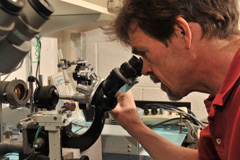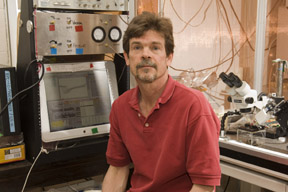Idaho State University neuroscientist Groome receives NIH grant to study human electrical channels to fight disease
May 27, 2009
Our bodies, in some senses, are one big electrical grid, and Idaho State University molecular neuroscientist James Groome is studying electrical pathways in genetically altered cells he has produced to help understand and fight diseases such epilepsy and other genetic disorders.
Groome, an associate professor in biological sciences, recently received a $213,417 grant titled “Channelopathy Based Investigation of Domain-Specific Functions in Sodium Channels” from the National Institutes of Health to help him continue some of his investigations.
 Before going into detail about his research, it is worth noting just how electrical and charged up we humans are.
Before going into detail about his research, it is worth noting just how electrical and charged up we humans are.
“Every cell has electrical potential,” Groome said. “The inside of a cell is different electrically compared to the outside, which is electrically excitable. Cells use action potentials to send information very, very rapidly over a distance. For example, motor neurons in the spinal cord need to send a signal a meter in distance in a couple of milliseconds, at high frequency, several hundred times per second. Without action potentials there is no way that can happen.”
Groome is studying channels in the neuron cells of the brain, muscle fibers for the skeleton and of the heart. These cells use electrical impulses as part of their function when our brain sends signals. When a neuron sends information the first thing it must do is send an “action potential,” which is a rapid change in voltage across a membrane.
“The action potential is absolutely critical for cells to do their function,” Groome said.
Many genetic disorders are caused when the ion channels in cells mutate and don’t function properly and the action potential is interrupted. Groome and his colleagues are focusing on sodium channel mutations in epilepsy, cardiac arrhythmia and muscle myotonia.

“Using very high-tech stuff we compare the activity of the ion channels produced by normal genes with mutated genes,” Groome said. “The goal is to try to identify the specific defects these mutation cause in the hopes of developing new pharmaceuticals.”
The ISU researchers are looking at a new direction in this field of research, examining ways to identify specific channels in a cell, not all the channels in a cell. Some drugs designed to treat epilepsy, for example, block the function of all channels in a cell when just blocking the activities of the specific channel in a cell would be more beneficial.
Groome is an IDeA Network of Biomedical Research Excellence (INBRE) funded scientist at ISU, proving the value of that program. A $16.5 million INBRE renewal grant awarded to Idaho colleges and universities this spring supports undergraduate, graduate and faculty research and other statewide efforts. The grant is the third major award for the network founded in 2001 and brings the total federal investment to $40 million.
The NIH Institutional Development Award Program, or IDeA, supports programs in 23 states that have smaller capacities to conduct biomedical research. The program is based in the NIH National Center for Research Resources.
Groome’s new grant is the third NIH grant awarded to a neuroscientist at ISU. The other two NIH grants to ISU neuroscientists are:
1) a $223,080 grant “Role of gonadal hormones in HPA responses to alcohol administration in the rat” grant to Daniel Selvage, assistant professor of biomedical and pharmaceutical sciences and also an INBRE-funded ISU faculty member; and
2) a $296,000 NIH grant titled “Sleep Problems and Substance Use/Abuse in Adolescence and Young Adulthood” to Maria Wong, associate professor of psychology.
These three scientists and their colleagues in their respective departments have formed the Snake River Association for Neuroscience, that has an overall mission to promote intellectual discussion of neuroscience across a broad range of perspectives.
“For each of the departments that make up our neuroscience group we have had some success in attracting NIH funding,” Groome said. “That says a lot about Idaho State University that our neuroscience community has attracted NIH grants.”
Categories:
